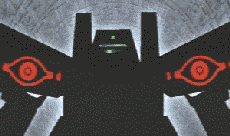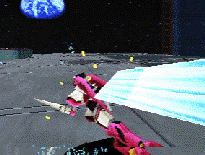Conquer the world with love!
Yeah, right! If you believe that, I’ve got a bridge to sell ya! What you need is firepower, and lots of it! Weird alien technology has taken over the Lunar Base. You are a test subject connected neurally in a simulated mech battle. If you win, you earn the honor of fighting in a real battle on the moon. You can connect to eight different mechs and participate in one-on-one battles to the death. Good Luck! (You’ll need it.)
Virtual On: Cybertroopers is yet another fighting game made by the folks at Sega. Before you groan in agony, let me tell you, this one is different. The control has two different forms of movement. Much like tank games, you can look one direction and move another. Set in a three dimensional arena, you can hide behind obstacles and then surprise your enemy by leaping into the air. Playing Virtual On is unlike any other fighting game out there and may bring new life to one of the most repetitive genres ever. (Second only to the Doom-type games.)
The polygonal graphics are done pretty well. They are a definite improvement from Sega’s lackluster performance with Fighting Vipers. Faster than superman on a sugar high, your mechs can zoom about at a blistering speed. The first couple of times you play Virtual On you aren’t going to know exactly what is going on at all times. Knowing that they were dealing with the load time of the CD, Sega added the option to turn off some of the non-game graphics to get you back into the game faster. The first few times, the character select and the continue screen look cool, but, when you get tired of the added load time, you can simply disable them (you have no patience, grasshopper). This option is a welcome addition to this game, and I feel that we will be seeing a lot more of it in the future.

The control is the most difficult part of the game. It was designed with the double joystick idea, reminiscent of Assault. There is even a “Twin Stick” available for those people who love the game enough to get a specialized controller. For those who can’t afford to do that, you have to make do with the normal controller. The D-pad is used for absolute movement (aka forward moves forwards, left moves left, etc.). In order to change the direction that you are viewing, you use the L and R buttons. This control does take awhile to get used to and may frustrate you in the beginning.
The most annoying part of Virtual On is having to listen to the awful background music. It seems as if the designers whipped up the music for the entire game in about fifteen minutes. It’s light-hearted happy fun time music that does NOT get you in the mood to blow up your enemy. The weapon sound effects are fine, but some of the other extraneous sound effects are poor.
Another aspect that drains this game is the cheesy character design on two of the characters. One of the characters, a strange female robot with large bunny ears, has a weapon that shoots large hearts at her opponents. As if that wasn’t bad enough, the designers named one of the mechs ‘Dorkas’. While, to the Japanese, this might have been a cool name, the people who translated the game for the American market should have realized that naming a character Dorkas would make even the most sophisticated person giggle. Other then those two problem children, the other characters are pretty well designed.
All in all, Virtual On is a refreshing change in the fighting genre. The interface is a lot of fun to play, and the computer opponents are remarkably hard. This new fighting format could be excellently integrated into other game genres, such as an RPG or adventure, adding more depth to the game. A sort of cyber-punk meets Robotech game in which you had to complete different missions would be perfect. That aside, Virtual On is definitely worth a closer look by fighting fans.
-
= Good Graphics.
-
+ Cool Interface.
-
+ Fun battles.
-
+ Something New in the Fighting Genre
-
- Control designed for 2 joysticks.
-
- Bad Music.











